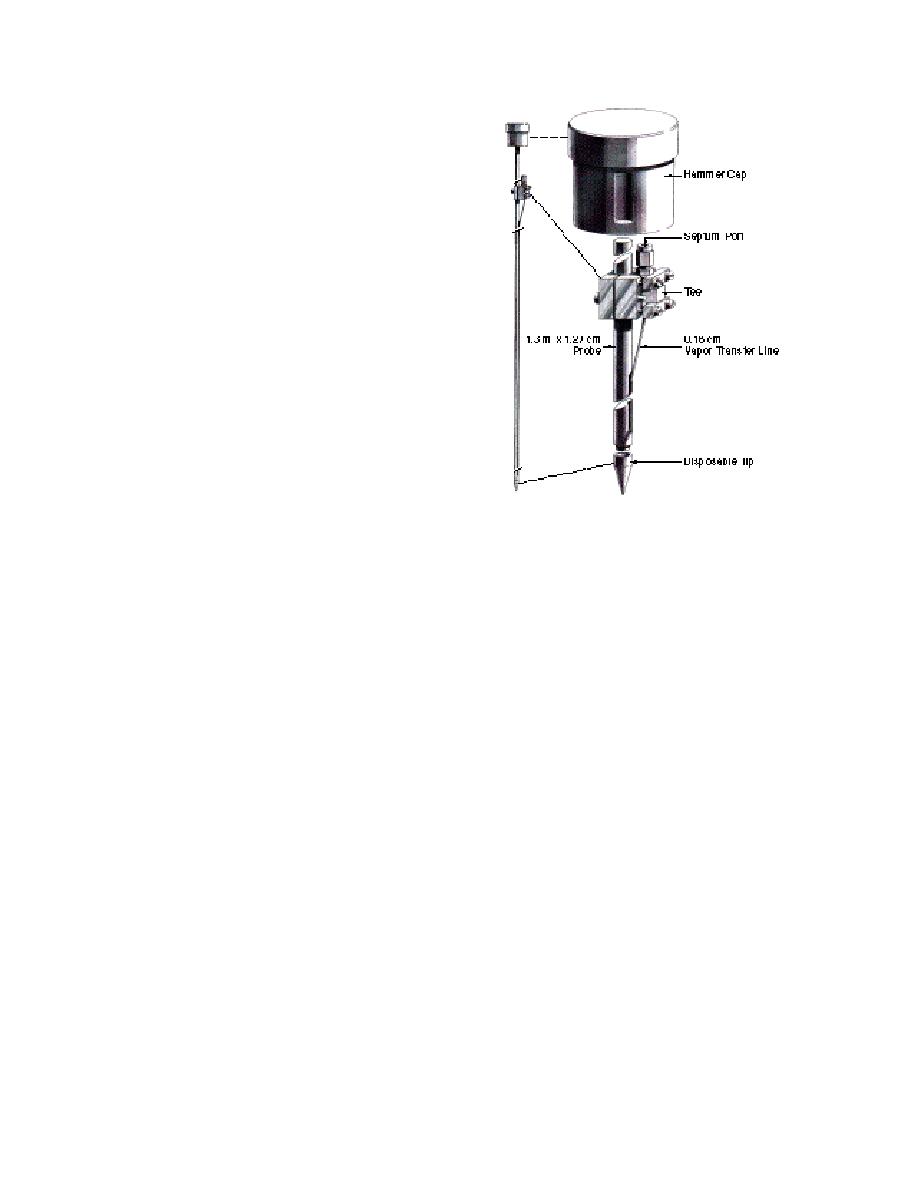
ple collection, handling, and analysis techniques,
the U.S. Environmental Protection Agency has
now adopted new methodologies (Method 5021
and Method 5035) (third update to the Test Meth-
ods for Evaluating Solid Waste, SW-846, [U.S. EPA
1986]). To help maintain representative VOC
concentrations, both methods 5021 and 5035 rec-
ommend that samples be collected with a coring
tool and be either immediately transferred to pre-
pared collectionanalysis vials or stored for less
than 48 hours in En Core samplers. Samples trans-
ferred to a prepared vial are typically either ana-
lyzed directly (vapor being removed by punctur-
ing a Teflon-lined septum cap with a needle), as
would be the case for headspace and purge-and-
trap analysis, or the VOCs of interest are extracted
into methanol, to be analyzed later. The En Core
sampler is a coring tool with a chamber that can
be hermetically sealed, thus allowing discrete
samples to be taken to a laboratory before the
preparation steps necessary for later instrumental
analysis are begun (Hewitt 1997).
Figure 1. Soil-vapor probe.
This study determines VOCs with a headspace
analysis of a discrete soil sample dispersed in wa-
ter. Therefore, vials of known weight containing
water were taken to the field so that samples
connected to the groove on the outside of the rod.
could be transferred directly to them. Further-
A 1.2-m-long section of the 0.16-cm-o.d. tubing,
more, to limit exposure, discrete soil samples
with a ferrule on the end, was threaded through
were obtained with a coring tool that reached the
the hole and epoxied into the groove, leaving
depth of interest (1 m), obtaining and transferring
only a 20-cm section not directly attached to the
the sample in a single step.
rod, at the top. After the epoxy had hardened, it
Along with comparing the two methods of
was sanded, leaving a smooth surface over the
characterizing VOC contamination in the vadose
groove. The tapered hole at the tip allowed the
zone, this study also assessed the performance of
ferrule on the end of the stainless steel tube to be
the above-mentioned soil-vapor probe. In addi-
recessed, leaving the entrance to the transfer line
tion, other issues associated with the collection,
flush with the bottom of the rod. At the top of the
handling, and storage of soil-vapor samples were
transfer line, a ferrule and nut assembly was
examined.
used to connect the tube to a stainless steel Tee.
The side port of the Tee was sealed with a cap,
while a stainless steel reducing union (0.32 0.16
PROBE DESIGN
cm), with a Teflon-lined septum, was used to seal
The soil-vapor probe was made of a steel rod
the top. This Tee was firmly held to the rod by an
that was 1.3 m in length and 1.27 cm in diameter.
aluminum block (see Fig. 1). The total dead vol-
Its soil-vapor transfer line was a spare part for a
ume for this soil-vapor transfer line was approx-
purge and trap instrument (Tekmar), consisting of
imately 1.2 mL.
a stainless steel tube, 0.16 cm o.d., 0.10 cm i.d.,
Two pieces that were not attached to the probe
with a nickel-plated liner. The transfer line was
were a brass disposable tip (see Fig. 1) and a snug
attached to the rod via a 0.318-cm groove (wide
fitting hammer cap made out of steel. The tips
deep) cut into the rod's exterior. The groove was 1
had a sharp point, were 3 cm long, and had a re-
m long, running between 1.3 cm from the tip to 25
cessed hole that allowed them to loosely fit over
cm from the top. The tip of the rod was machined
the post on the tip of the probe. The hammer cap
down to a 0.95-cm diam. 0.32-cm-deep post (see
was a cylindrical (7-cm-diam. 7-cm-long) solid
Fig. 1). In the middle of this post, a small (0.32-cm-
piece of steel, with a 1.3-cm hole drilled 75% of
diam. tapered to 0.20-cm) hole was drilled, which
the way through the middle, on one end.
2



 Previous Page
Previous Page
